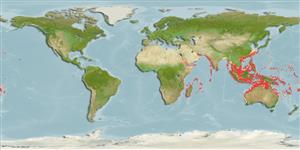Classification / Names
Common names from other countries
Main reference
Size / Weight / Age
Max length : 150 cm TL male/unsexed; (Ref. 2871); common length : 120 cm TL male/unsexed; (Ref. 5450); max. published weight: 11.5 kg (Ref. 40637)
Environment
Marine; brackish; reef-associated; oceanodromous (Ref. 51243); depth range 20 - 200 m (Ref. 28016), usually ? - 60 m (Ref. 90102)
Climate / Range
Tropical, preferred 26°C (Ref. 107945); 27°N - 37°S, 29°E - 152°E
Distribution
Indo-West Pacific: Red Sea (Ref. 12541) south to the southeastern coast of South Africa and east to New Caledonia and Vanuatu. Recently reported from Tonga (Ref. 53797). Due to a widespread confusion with Sphyraena putnamae and Sphyraena qenie, the exact range is uncertain.
Countries | FAO areas | Ecosystems | Occurrences | Introductions
Short description
IUCN Red List Status (Ref. 115185)
Threat to humans
Reports of ciguatera poisoning (Ref. 31637)
Human uses
Fisheries: commercial; gamefish: yes
More information
Common namesSynonymsMetabolismPredatorsEcotoxicologyReproductionMaturitySpawningFecundityEggsEgg development
Tools
Special reports
Download XML
Internet sources
Estimates of some properties based on models
Phylogenetic diversity index
PD50 = 0.5000 many relatives (e.g. carps) 0.5 - 2.0 few relatives (e.g. lungfishes)
Trophic Level
4.5 ±0.6 se; Based on diet studies.
Resilience
Low, minimum population doubling time 4.5 - 14 years (K=0.10)
Vulnerability
Very high vulnerability (75 of 100)
Price category
